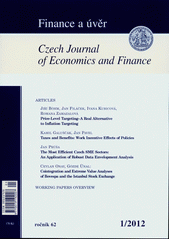Roles of artificial intelligence in bank-firm loan decisions: a game-theoretic analysis
Main Article Content
Abstract
Objectives: This study aims to develop a game-theoretic model to analyze the impacts of Artificial Intelligence (AI)-based credit risk assessment on the strategic decisions of banks and firms in the loan market.
Significance: Understanding these dynamics is crucial for enhancing financial inclusion, reducing credit access barriers for SMEs and improving lending outcomes for banks.
Methods: The study constructed a game-theoretic framework in which banks set loan terms while firms decide whether to accept these terms based on their expected returns, creditworthiness and alternative financing options. The theoretical model involves baseline analysis; then consider the impacts of AI-driven risk assessment and finally perform some comparative statics analysis.
Results: The analysis revealed that incorporating AI reduces uncertainty in default risk assessment, promotes financial inclusion for SMEs and enhances regulatory compliance.
Recommendations: The study recommends that regulators develop frameworks that incentivize banks to adopt AI in risk assessment.
Article Details
Issue
Section

This work is licensed under a Creative Commons Attribution-NonCommercial-NoDerivatives 4.0 International License.
How to Cite
References
Acharya VV, Naqvi H (2019): Risk-Taking Incentives in Banking and the Role of Regulatory Oversight. Journal of Economic Perspectives, 33(1):23–46. https://doi.org/10.1257/jep.33.1.23
Akerlof GA (1970): The Market for “Lemons”: Quality Uncertainty and the Market Mechanism. The Quarterly Journal of Economics, 84(3):488–500. https://doi.org/10.2307/1879431
Allen F, Gale D (2004): Financial Intermediaries and Markets. Econometrica, 72(4):1023–1061. https://doi.org/10.1111/j.1468-0262.2004.00525.x
Benmelech E, Bergman N (2021): Collateral and Credit Market Dynamics. Quarterly Journal of Economics, 136(4):2185–2223. https://doi.org/10.1093/qje/qjaa025
Berger AN, Udell GF (2021): Relationship Lending and Credit Access for Small Businesses. Journal of Banking & Finance, 132(1):45–68. https://doi.org/10.1016/j.jbankfin.2021.106216
Berger AN, Frame WS, Miller N (2022): Digitalization and the Future of Bank Lending. Journal of Financial Intermediation, 49:100940. https://doi.org/10.1016/j.jfi.2021.100940
Bertoni F, Colombo MG, Grilli L (2021): Bank Loan Rejections and Entrepreneurial Financing Strategies. Entrepreneurship Theory and Practice, 45(5):1230–1257. https://doi.org/10.1177/1042258720936790
Bolton P, Freixas X, Shapiro J (2018): Bank Lending and Information Asymmetry. Journal of Financial Economics, 128(2):266–284. https://doi.org/10.1016/j.jfineco.2018.03.002
Boot AWA, Thakor AV (2018): Risk Sharing and the Design of Financial Contracts. Review of Financial Studies, 31(6):2140–2172. https://doi.org/10.1093/rfs/hhx140
Brown JR, Martinsson G, Petersen BC (2020): Do Financial Constraints Stifle Innovation? American Economic Review, 110(5):1595–1620. https://doi.org/10.1257/aer.20181513
Chen X, Lin Z, Zhang W (2021): Game-Theoretic Approaches to Credit Risk Assessment in Banking. Journal of Risk Finance, 22(4):384–404. https://doi.org/10.1108/JRF-04-2020-0045
Cowling M, Siepel J (2020): Strategic Borrowing Behavior of Innovative Firms. Small Business Economics, 54(1):71–87. https://doi.org/10.1007/s11187-019-00135-y
Diamond DW (1984): Financial Intermediation and Delegated Monitoring. The Review of Economic Studies, 51(3):393–414. https://doi.org/10.2307/2297430
Diamond DW (2021): Asymmetric Information and Bank-Firm Lending Dynamics. Journal of Economic Theory, 156(5):1118–1140. https://doi.org/10.1016/j.jet.2021.01.001
Eberhart AC, Altman EI (2020): Bankruptcy Costs and the Pricing of Bank Loans. Journal of Financial and Quantitative Analysis, 55(2):315–340. https://doi.org/10.1017/S0022109018000823
Frost J, Gambacorta L, Huang Y, Shin HS, Zbinden P (2022): BigTech and the Changing Structure of Financial Intermediation. Annual Review of Financial Economics, 14:189–214. https://doi.org/10.1146/annurev-financial-012821-120716
Fuster A, Plosser M, Schnabl P, Vickery J (2022): The Rise of Digital Credit Scoring. Review of Financial Studies, 35(2):490–526. https://doi.org/10.1093/rfs/hhaa124
Gale D, Hellwig M (1985): Incentive-Compatible Debt Contracts: The One-Period Problem. The Review of Economic Studies, 52(4):647–663. https://doi.org/10.2307/2297738
Jensen MC, Meckling WH (1976): Theory of the Firm: Managerial Behavior, Agency Costs, and Ownership Structure. Journal of Financial Economics, 3(4):305–360. https://doi.org/10.1016/0304-405X(76)90026-X
Kashyap AK, Lamont O, Stein JC (2020): Credit Risk and the Mitigation of Moral Hazard in Lending. Journal of Financial Economics, 137(3):814–839. https://doi.org/10.1016/j.jfineco.2019.06.012
Laeven L, Levine R (2022): Banking Regulations and Lending Behavior. Journal of Financial Intermediation, 48(3):1008–1032. https://doi.org/10.1016/j.jfi.2022.100932
Murphy AE (2009): Richard Cantillon and the Origins of Economic Theory. History of Economic Thought, 3(1):85–98.
Papoutsi M (2018): Loan Renegotiations and Moral Hazard in Bank-Firm Relationships. European Economic Review, 110:147–167. https://doi.org/10.1016/j.euroecorev.2018.09.004
Rajan RG, Winton A (2020): Dynamic Lending Relationships and Credit Market Efficiency. Journal of Banking & Finance, 120:105743. https://doi.org/10.1016/j.jbankfin.2020.105743
Rajan RG, Zingales L (2019): Strategic Loan Pricing in Competitive Credit Markets. Journal of Financial Economics, 134(3):489–516. https://doi.org/10.1016/j.jfineco.2019.03.006
Spence M (1973): Job Market Signaling. The Quarterly Journal of Economics, 87(3):355–374. https://doi.org/10.2307/1882010
Stiglitz JE, Weiss A (1981): Credit Rationing in Markets with Imperfect Information. The American Economic Review, 71(3):393–410. https://doi.org/10.2307/1802787
Zhang L, Wang J, Chen R (2023): AI and Predictive Modeling in Credit Risk Management. Journal of Financial Innovation, 7(4):88–102. https://doi.org/10.1007/s10812-022-99934-7

